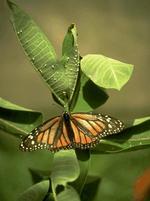 |
 |
 |
 |
 |
 |
 |
About the Monarch Migration Study
(Back to Monarch Home Page)
|
|
How Your Can Help Track the Spring, 1999 Monarch Migration
Journey North tracks the monarch migration each year by collecting sightings of the FIRST monarch butterfly an
observer sees in the spring. A migration map is produced every week, providing a "live" snapshot of the
migration as it progresses.
- Monarch Butterfly Migration Checklist: Please print this checklist and take it with you in the field. Take notes on the topics listed. When you report your monarch sightings to Journey North, please include as much of this information as possible in the "Comments" section.
About the Monarch Migration
Every spring, millions of monarch butterflies re-populate eastern North America after surviving the winter
in the high mountains west of Mexico City. They flew up to 2,500 miles to get there last fall and spent the winter
living off their fat reserves. With just a few weeks to live, they'll race to produce the next generation. The
following fall, by instinct alone, the great-grandchildren of these butterflies will return to the very same mountain
sanctuaries. The information for this incredible journey is somehow passed from generation to generation so that
miraculously the butterflies return to a place they've never seen before.
|
Migration Route of the Monarch |
Location of Monarch Sancturies in Mexico |
|
|
Important Notes
Report Sightings of Monarch Eggs
In addition to reporting your first adult monarch, please report the FIRST MONARCH EGGS you see on milkweed.
(Because when you see monarch eggs, you'll know monarchs have arrived in your region!)
Identification of Milkweed & Monarch Eggs
 |
|
Monarch Eggs Don't expect to see milkweed with more than one egg per leaf. This monarch layed eggs in captivity, so deposited many on a single leaf. Photo by Karen Obserhauser |
Monarchs Wintering Outside of Mexico
Residents of the Gulf States and California: Please help us document whether monarchs have remained in your
region throughout the winter. Report NOW if monarchs are present.
California Monarch Overwintering Sites
Various factors make tracking migration from the West Coast overwintering sites much more difficult to track than
the migration from Mexico. (There are several hundred sites, many are very small, they are spread over many hundreds
of miles along the coast, they break up at different times, etc.) However, we encourage our California readers
to help us improve this effort. If you visit the sites or have information about their spring break-up, please
report your observations.
Don't Report Captive-bred Monarchs
If you raise and release monarchs, please do not report about them. The purpose of this study is to follow the
natural migration. Please be very careful NOT to report monarchs which you have raised and released!
Copyright 1999 Journey North. All Rights Reserved. Please send all questions, comments, and suggestions to our feedback form
 |
 |
 |
 |
 |


